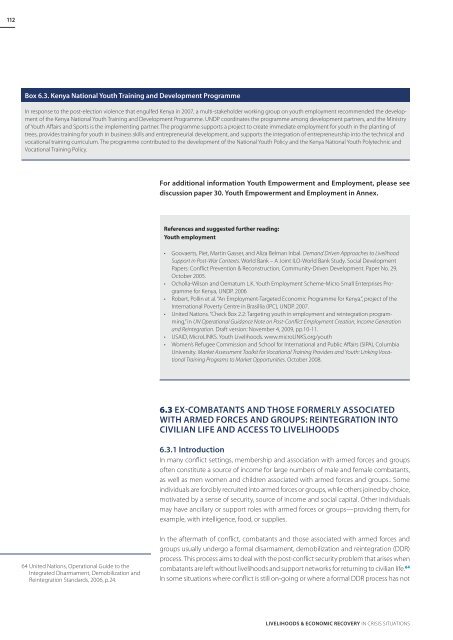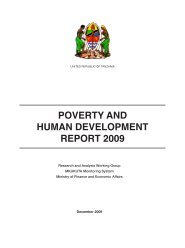Download PDF (4.08 MB) - ReliefWeb
Download PDF (4.08 MB) - ReliefWeb
Download PDF (4.08 MB) - ReliefWeb
Create successful ePaper yourself
Turn your PDF publications into a flip-book with our unique Google optimized e-Paper software.
112<br />
Box 6.3. Kenya National Youth Training and Development Programme<br />
In response to the post-election violence that engulfed Kenya in 2007, a multi-stakeholder working group on youth employment recommended the development<br />
of the Kenya National Youth Training and Development Programme. UNDP coordinates the programme among development partners, and the Ministry<br />
of Youth Affairs and Sports is the implementing partner. The programme supports a project to create immediate employment for youth in the planting of<br />
trees, provides training for youth in business skills and entrepreneurial development, and supports the integration of entrepreneurship into the technical and<br />
vocational training curriculum. The programme contributed to the development of the National Youth Policy and the Kenya National Youth Polytechnic and<br />
Vocational Training Policy.<br />
For additional information Youth Empowerment and Employment, please see<br />
discussion paper 30. Youth Empowerment and Employment in Annex.<br />
References and suggested further reading:<br />
Youth employment<br />
• Goovaerts, Piet, Martin Gasser, and Aliza Belman Inbal. Demand Driven Approaches to Livelihood<br />
Support in Post-War Contexts. World Bank – A Joint ILO-World Bank Study. Social Development<br />
Papers: Conflict Prevention & Reconstruction, Community-Driven Development. Paper No. 29,<br />
October 2005.<br />
• Ocholla-Wilson and Oematum L.K. Youth Employment Scheme-Micro Small Enterprises Programme<br />
for Kenya, UNDP. 2006<br />
• Robert, Pollin et al. “An Employment-Targeted Economic Programme for Kenya.”, project of the<br />
International Poverty Centre in Brasillia (IPC), UNDP. 2007.<br />
• United Nations. “Check Box 2.2: Targeting youth in employment and reintegration programming,”<br />
in UN Operational Guidance Note on Post-Conflict Employment Creation, Income Generation<br />
and Reintegration. Draft version: November 4, 2009, pp.10-11.<br />
• USAID, MicroLINKS. Youth Livelihoods. www.microLINKS.org/youth<br />
• Women’s Refugee Commission and School for International and Public Affairs (SIPA), Columbia<br />
University. Market Assessment Toolkit for Vocational Training Providers and Youth: Linking Vocational<br />
Training Programs to Market Opportunities. October 2008.<br />
6.3 EX-CO<strong>MB</strong>ATANTS AND THOSE FORMERLY ASSOCIATED<br />
WITH ARMED FORCES AND GROUPS: REINTEGRATION INTO<br />
CIVILIAN LIFE AND ACCESS TO LIVELIHOODS<br />
6.3.1 Introduction<br />
In many conflict settings, membership and association with armed forces and groups<br />
often constitute a source of income for large numbers of male and female combatants,<br />
as well as men women and children associated with armed forces and groups.. Some<br />
individuals are forcibly recruited into armed forces or groups, while others joined by choice,<br />
motivated by a sense of security, source of income and social capital. Other individuals<br />
may have ancillary or support roles with armed forces or groups—providing them, for<br />
example, with intelligence, food, or supplies.<br />
64 United Nations, Operational Guide to the<br />
Integrated Disarmament, Demobilization and<br />
Reintegration Standards, 2006, p.24.<br />
In the aftermath of conflict, combatants and those associated with armed forces and<br />
groups usually undergo a formal disarmament, demobilization and reintegration (DDR)<br />
process. This process aims to deal with the post-conflict security problem that arises when<br />
combatants are left without livelihoods and support networks for returning to civilian life. 64<br />
In some situations where conflict is still on-going or where a formal DDR process has not<br />
Livelihoods & Economic Recovery in Crisis Situations





